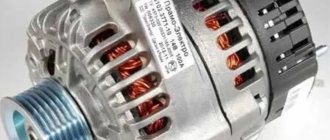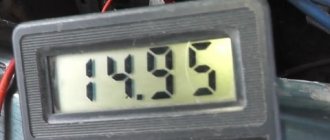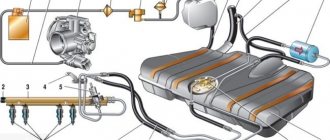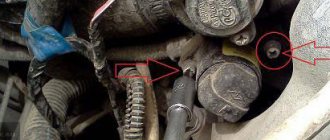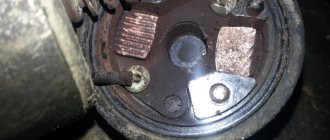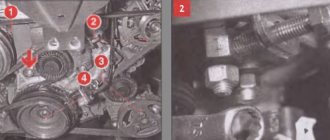The generator does not work on the VAZ 2112
When the engine is running, the electrical equipment of the VAZ-2112 passenger car receives power from the standard right-hand rotation generators installed on AvtoVAZ, type 94.3701 (13.2-14.7V, 80A). The generator is constantly monitored by the battery charge lamp, which is located on the instrument panel. When the ignition is turned on, this lamp should light up and go out immediately after the engine starts, which will indicate that the generator is working. When this lamp continues to light while the engine is running, this is a signal to the driver that some kind of generator malfunction has occurred, and the consumers are currently being supplied with electrical energy from the battery.
In order to make sure that the generator is faulty, you need to start the engine and, by pressing the gas pedal, raise the crankshaft speed to just over 3000 rpm. Then, turn on the high beams and all other consumers of electrical energy, and use a tester to measure the voltage at the battery terminals. If it turns out to be below 13 volts, then your assumption about a generator malfunction is correct.
Troubleshooting begins by checking the condition of the voltage regulator relay and the graphite brushes, which are located in the brush holder housing. To do this, you will need to remove the plastic cover from the back of the generator and unscrew a couple of screws to remove the brush holder. We check the brushes visually, and the voltage regulator, using a test lamp with a power of 1 to 5 watts, which is connected to the brushes. A voltage of +12 volts from the battery is supplied to the regulator relay contacts “ground” and “D+”. If the lamp does not light, it means that there is a break in this electrical circuit, and since the relay regulator is not repairable, it will have to be replaced.
But if the control lamp is on, then you will have to add a pair of 2 volt batteries connected in series with the battery to this circuit to increase the voltage in the circuit to 16 volts. If, during this check, the control lamp goes out, it means that the voltage regulator relay is working. And if the lamp continues to light, this will mean a breakdown of the voltage regulator, which will have to be replaced.
If the voltage regulator relay is working properly, then you will have to check the valves of the diode bridge, as well as the rotor and stator windings. But it is better to entrust this to an auto electrician, since the generator will still have to be removed from the car engine.
Source
Video “How to properly test a generator unit”
You can learn more about diagnosing a generator at home from the video below (the author of the video is AutoHandMade).
The battery and generator are the two sources of electricity in any car. The battery starts the engine and powers the on-board network. The battery loses charge when starting and powering electrical equipment, and the generator recharges the battery and maintains the required voltage in the network.
When operating a car, sometimes a situation arises when the battery does not receive a charge from the generator or does not receive enough of it.
Why is the battery not charging?
If the generator does not charge the battery when the engine is running, it quickly discharges to the minimum permissible values. When the alternator is not charging the battery enough, it is more difficult to detect. Most modern cars are equipped with indicators that show that the battery charge is insufficient. If the icon lights up on the dashboard, this is a sign that the generator is not supplying current to the network, and the vehicle's electrical equipment is powered by the battery.
If we exclude a malfunction of the battery itself, then there may be several breakdowns due to which the generator does not charge the battery.
Fuse burned out
Check to see if the indicator on the dashboard showing the battery charge is faulty. Read the technical description for your car for information about the fuse. Check its suitability with a special device. Start the car. If the indicator icon goes out, that's good. This means there are no problems with the car generator.
Broken alternator belt
A common case is when there is no voltage coming from the generator. Even a high-quality alternator belt wears out and breaks over time. It needs to be changed after a certain mileage (manufacturers indicate this figure), and not when you discover a malfunction in the car.
Alternator belt tension is loose
This is the second reason why the generator does not fully charge the battery. The belt blade may be in good condition, but its tension weakens over time. The generator does not provide sufficient voltage to charge the battery. The reason why the battery drains quickly not only when the car is moving, but also when it is stationary is precisely because the belt tension is insufficient.
Adjusts the tension. This work will take a little time. In the future, do not forget to check the belt tension. From the car manual you will learn about the frequency (in engine hours) when you need to check this parameter.
Some time after replacing the belt, it is recommended to check the tension again. The characteristic whistle that is heard when the engine speed increases sharply will tell you that it needs adjustment. You can adjust the tension yourself. You will need a pry bar and an open-end or socket wrench.
Damaged contacts or wiring
The battery often does not receive a charge from the generator due to oxidation of the contacts or defective wires. Therefore, periodically check the integrity of the insulation and power cable connecting the generator and battery. If you find a defect in the wires or cracks in the insulation, then it is wiser to immediately replace the entire wire.
Clean the contacts from carbon deposits and oxide. When the generator operates under load, a spark appears between the brushes and the commutator, causing ionization of the air. In such an environment, the terminals oxidize and a coating appears on them, which makes it difficult to transmit voltage.
If you see oxide, remove it with fine-grained sandpaper or a soft iron brush. Carry out the work carefully so as not to damage the surface of the terminals. Otherwise, due to deep scratches and dents, the contact area will decrease, which will lead to heating at the joints. As a result, sparks will appear and the charging current will be unstable.
Generator voltage regulator faulty
The engine speed is constantly changing, so the generator voltage fluctuates widely. To stabilize the voltage, a regulator is installed on the generator. A faulty generator voltage regulator is a serious problem, but it is rare.
Possible malfunctions and their diagnosis
Generating equipment is exposed to a variety of adverse effects during operation.
The main negative factors causing generator failure:
- aggressive liquids, dirt, condensation;
- temperature changes, overheating,
- mechanical wear;
- transient processes in on-board wires, contributing to electrical breakdown;
- ugly, ill-conceived exploitation.
Some faults can only be fixed by a professional auto electrician. Most breakdowns are discovered on their own and repaired by an ordinary car owner with the correct hand anatomy.
External signs that draw the motorist's attention to unstable operation of the generator.
- After starting the engine, unpleasant noises of various nature are heard in the engine compartment, and the smell of burnt rubber is felt.
- The instrument panel shows that the battery is discharged and is not charging well.
- There are difficulties starting the engine, the battery has been checked and charged.
- The light bulbs burn at full intensity, flicker, and change brightness depending on the crankshaft speed. The lighting of the panel and interior is dim.
- An external inspection reveals mechanical damage to the housing and generator elements.
Possible breakdowns
- insulation destruction, short circuit, winding wire breakage;
- overheating, belt rupture;
- leakage of lubricant, knocking, destruction, jamming of ball bearings;
- malfunction of electronic parts of the rectifier circuit, regulator.
Troubleshooting Methods
Two diagnostic methods are usually used:
- Visual control.
- Metrological testing.
The first option allows you to identify contamination, traces of mechanical and chemical influence. Exceeding the temperature regime is determined by physical contact. After turning off the ignition, you need to lift the hood and slowly move your hand towards the generator. The increased temperature will be felt at a minimum distance, before touching.
To implement the second activity, you need to equip yourself with a measuring device and acquire basic skills in measuring resistance, voltage, and current.
Checking the VAZ 2112 generator with a multimeter
A classic pointer tester, a modern electronic multimeter with a liquid crystal screen, is suitable as a testing device. Set the switch to the “DC voltage measurement” position, limit 0-30V.
- First step. The ignition is turned off. Battery voltage measurement. The norm is 12.5-12.7V.
- Second step. The engine is running at idle speed. Consumers are disabled. The measurement shows 13.8-14.5V.
- Third step. Turn on the lights and music. Normal range is 13.7-14V. Pressing the gas pedal does not raise the voltage by 0.5V. A value exceeding 15V indicates a regulator failure. A faulty generator will not produce more than 13V.
Checking the diode bridge
The tester is in the “resistance measurement” position. The straightener consists of two parts. One clip contains three diodes with anode contacts on the body. The other is with cathode ones. The whole valve in the forward direction will show 0 ohms. The reverse resistance is 600 kOhm. An infinite value means a break; a zero value means the diode is broken.
Winding measurement
To check the field windings, you need to touch the slip rings with the probes of the device. The working value is from 1.8ohm to 5ohm. Readings outside the specified numbers indicate a malfunction.
The stator windings are checked in two modes - among themselves, for ground. In the first case, a value of several ohms is accepted as correct. In the second option, an infinitely large reading satisfies.
Fault options
There are several possible faults – let’s look at the most common ones.
| Cause of malfunction | Nuances |
| Device is overloaded | This malfunction is typical for those who like to install various equipment using the generator. For example, video devices or speakers. A conventional generator is not designed for such overloads, and therefore cannot cope with the load. |
| The battery does not match the characteristics of the generator | With a conventional generator, some decide to install a more powerful battery. As a result, the generator cannot cope with the more powerful battery. He does not have the necessary resources for this. |
Removal and installation of VAZ 2112 generator
The process of removing the unit will require a minimum list of tools:
- standard set of open-end wrenches, heads, wrenches;
- flathead, Phillips head screwdrivers:
- pliers;
- rags.
In hard-to-reach places it is more convenient to work with a ratchet wrench. Fasteners for machines with different configurations and year of manufacture differ. The most suitable equipment should be used.
Step-by-step instructions for replacing the generator on a VAZ 2112
- Place the car over the inspection hole.
- Raise the hood.
- Loosen the mounting bolt and disconnect the negative terminal of the battery.
- While under the car, remove the protective sheet and provide access from below.
- Disconnect the wires. If the protective rubber cover is torn, consider replacing it.
- Unscrew the alternator belt tension adjusting bolt on the bracket.
- Remove the top mounting bolt. The lower fastener is released from the inspection hole.
- Move the generator towards the cylinder block, reduce the tension, remove the belt.
- Completely dismantle the bolts, bushings, nuts, and remove the product to the workbench.
- After performing repair and maintenance work, insert, secure, and adjust the belt tension in the reverse order.
Replacing the alternator belt
The rubber ring used on the VAZ 2112 is available in two modifications.
The car model equipped with air conditioning has a larger diameter belt that rests on three pulleys. Motivation for installing a new belt:
- The warranty period ends, approximately 40 - 50 thousand kilometers;
- During the next maintenance, critical signs of product destruction (scuffs, tears, severe stretching, delamination) were discovered.
The procedure is carried out according to the method described above, with the exception of:
- there is no need to completely remove the bolts; it is enough to allow the generator unit to be tilted freely;
- no need to disconnect wires.
Tension the belt using the adjusting bolt. The normal value is considered to be a deflection of 1 - 1.5 cm when pressing the tape in the middle between the crankshaft and generator pulleys.
Replacing the diode bridge, relay-regulator, brushes
External signs of a defect in the diode bridge are rapid discharge of the battery, strong heating of the generator housing.
Symptoms of voltage regulator failure are described above. On the VAZ 2112 generator, the regulator and brush assembly are structurally combined.
Fixing the breakdown will not be difficult. Remove the device to a workbench. The electronics are hidden under a plastic cover. Carefully disassemble the rear part with a screwdriver and wrenches. Defective elements are replaced. The main requirement is extreme care.
Reasons why your car battery does not charge
Below we will discuss the reasons why the battery may not charge. Diagnosing a lack of charging is not difficult, since this will immediately affect the condition of the battery. If during a trip the generator does not charge the battery, then the charged battery will completely drain. If the generator charges the battery, but not enough, it will be more difficult to immediately understand. The battery will simply drain faster than usual. But most cars have a battery charge indicator. There is an indicator on the dashboard that lights up if there are problems charging the battery. If the indicator is on, this means that no current is supplied from the generator and the power supply to consumers in the vehicle network comes from the battery.
If this is your case, then let’s move on to the reasons for the lack of charging from the generator. You can also read about the reasons for battery overcharging. It is also necessary to rule out problems with the battery itself. How to check your car battery for performance, read the article at the link.
Fuse burned out
First, it’s worth checking whether the battery charge indicator on the instrument panel itself is lying. Otherwise, you will look for a reason where there is none.
The first thing to do is check the fuse.
Find the appropriate fuse in your vehicle's manual. This information is usually contained in the electrical section. Find the fuse, check its condition and replace it if necessary. You start the engine and if the indicator goes out, then everything is fine with the generator and no repairs are required. Return to content
Broken alternator belt
This is probably one of the most common reasons for a generator not charging. The alternator belt, no matter how high-quality it is, wears out and periodically needs to be replaced.
It is better to carry out scheduled replacement of the alternator belt
It is better to change the belt after a certain mileage, as indicated in the car manual, and not wait until it breaks somewhere along the way.
Alternator belt tension is loose
Another reason why the battery may not be fully charged from the generator. Even if the alternator belt is in good condition, its tension may simply weaken, and the alternator will not produce enough voltage to charge the battery. This can cause the car's battery to drain quickly while parked.
Choosing a new generator
Despite the similarity of generators produced by different manufacturers, it is necessary to take into account a number of important factors.
The main arguments are the number of consumers, generation, and vehicle equipment. You should pay attention to the trade article, rated power, and originality of the product. It is more logical to provide a power reserve. Any device that does not operate at maximum loads will live longer. We should not forget about the wire cross-section and battery capacity. An increase in power entails an increase in current loads and overheating of the wiring. When choosing a new generator, you have to search for the golden mean. If energy consumption has not increased, additional consumers have not been connected, it is more correct to look for an analogue of the factory generator according to the article number. Source
